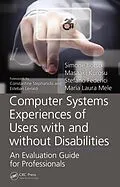This book provides the necessary tools for the evaluation of the interaction between the user who is disabled and the computer system that was designed to assist that person. The book creates an evaluation process that is able to assess the user's satisfaction with a developed system. Presenting a new theoretical perspective in the human computer interaction evaluation of disabled persons, it takes into account all of the individuals involved in the evaluation process.
Autorentext
Simone Borsci holds a PhD in cognitive psychology at the Sapienza University of Rome and currently works as a researcher at Brunel University of London. His researches are focused on different aspects of interaction: the user experience evaluation of interfaces and artifacts, the user preference analysis before and after use, the application of estimation models for determining an optimized sample size for an evaluation test, and the matching between assistive technologies/medical devices and users' needs. He is also an author or a contributor of more than 30 publications.
Masaaki Kurosu Stefano Federici Maria Laura Mele
Inhalt
Brief History of Human-Computer Interaction. Defining Usability, Accessibility, and User Experience. Why We Should Be Talking about Psychotechnologies for Socialization, Not Just Websites. Equalizing the Relationship between Design and Evaluation. Why We Need an Integrated Model of Interaction Evaluation. Why Understanding Disabled Users' Experience Matters. How You Can Set Up and Perform an Interaction Evaluation: Rules and Methods. Evaluation Techniques, Applications, and Tools. References. Index.
